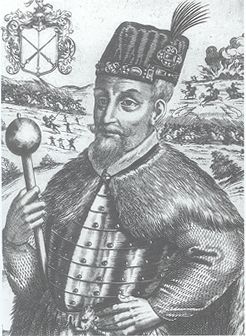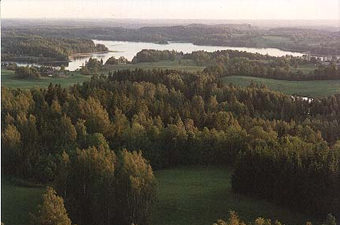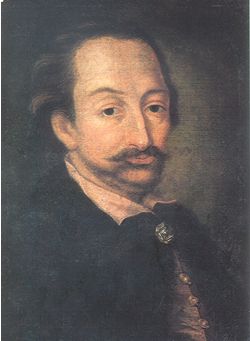
Battles and Campaigns
|
|
Swedish Polish War 1600 to 1609 Military Operations, from late 1601 to 1604 It was only until mid-summer that the Commonwealth had mobilised a large army under the nominal command of the King, though in reality commanded by the experienced Chancellor and Grand Royal Hetman Jan Zamojski. He was assisted by Zolkiewski and Farensbach. Zamoyski, 57, was a great organiser and had an impeccable military record which included the siege campaigns with King Stefan Batory (1579-1582). His army comprised:-
Some eleven thousand Swedish infantry were spread amongst eleven castles while 3,600 cavalry were at Dorpat under the command of Nassau. Duke Charles had returned home to Sweden.
Wolmar, which was held by Gyllenhjelm and a thousand men, was the Polish-Lithuanians' first target and a blockade was commenced on 18th October when advance units arrived. Wolmar was a well defended castle and town. The castle was on a hill above the town, which was protected by walls and a deep ditch. Zamojski formed four canon opposite the castle together with Scottish and German infantry under Faresenbach. Another four cannon targeted the town and they were defended by the Polish-Hungarian arquebusiers. The frozen ground made the construction of defensive earthworks slow and difficult. On 18th December, after the fortifications had been weakened by the artillery Zamojski ordered a general attack. The town was taken and the outnumbered Swedes took refuge in the castle. On the following day Gyllenhjelm accepted the terms of surrender and the remaining 518 defenders swore not to fight against the Commonwealth again and matched to Rewel, while Gyllenhjelm and Jacob de la Gardie were taken prisoner. The winter cold, hunger, disease and desertions had reduced the army to around 5,000 and further offensive action was unrealistic. Zamojski moved his forces towards Dopart and awaited spring. When thaw arrived Zamojski directed his forces at Felin which was held by 800 Swedes. On 25th March his advance units under Zolkiewski reached the town, followed a few days later by the main forces, while the heavy artillery arrived on 19th April. Under cover of the siege artillery Cossacks scaled the towns walls and took the town.
On 26th June Zamojski, with 2,900 cavalry, moved
on to Bialy Kamien and its 700 defenders. He began with a blockade
while he waited for reinforcements. The small Teutonic Knight castle
was placed amongst marshes and was one of the most modern in Livonia,
possessing a strong artillery. Zamojski sent Zolkiewski with a few hundred cavalry to destroy the Swedish cavalry which were standing at Rewel. On the approach of Zolkiewski the Swedes positioned themselves so as to be shielded by a stream and constructed field fortifications between the upper lake and bogs. So when the Commonwealth's forces arrived on 30th June there lacked the opportunity for a frontal attack by hussars. Instead in a brilliant encircling maneuver Zolkiewski sent his cossack cavalry around the lake. Travelling 16 km in two hours they struck the surprised Swedes in the rear. They fled losing 200 men and the Swedes at Bialy Kamien had lost their hope of relief. By the 7th of August the first infantry reinforcements arrived at Bialy Kamien, but at first the strong fortifications held out against the Polish-Lithuanian cannon. It was only when the batteries were moved to the marshy side - which required extensive construction work under enemy fire - was significant damage made to these weaker walls. At the end of September the castle capitulated, but the Polish cavalry insisted on a return home leaving 3,000 infantry. By the Autumn of 1602 almost all of Livonia and Estonia were in Polish-Lithuanian hands, with Swedish garrisons remaining only at Parnawa, Dopart, Rewel and Narwa. With Charles having difficulties with the Swedish parliament the opportunity arose for a comprimise, however the stubborn Zygmunt would not agree believing he could still regain his father's crown. Instead he sent 500 'Wybraniecka' Infantry reinforcements to help, while Zamojski aging and sick left for his home town of Zamosc after paying the army 19,000 Zloty from his own coffers. Zamojski's replacement should have been Grand Lithuanian Hetman Radziwill, who not wanting to serve under another's command had spent the Chancellor's campaign in Wilno. Radziwill excused himself due his health and financial complications (he still awaited repayment from the state for his funding of the army in the previous campaign) so in the middle of October the command passed to the Field Hetman, Chodkiewicz. The army had now risen to 4,000 and in December the siege of Dorpat commenced. The number of besiegers matched the Swedish garrison of 2,000. On the 5th March 1603 at Rakibor with 1,000 men Chodkiewicz defeated the Swedish relief force of 2,000 and on 13th April Dopart capitulated. Much of his forces were unpaid and could not be convinced to pursue further military operations. So in June Chodkiewicz formed a fortified camp south of Rakibor from where he directed minor operations - in the form of cavalry raids. The Battle of Bialy Kamien (Paide) With this victory, following the recent death of Radziwill, the Grand Hetman's mace passed to Chodkiewicz. |
|
|||||||||||||||||||||||||||||||||||||||||||||||||||||||||||||||||||||||||||||||||||||||||||||||||||||||||||||||||||||||||||||||||||||||||||||||||||||||
![]()
 While
Zamojski gathered the army at Rakiszki on the Kokenhausen - Wilkomierz
- Wilno road Duke Charles and Jan Nassau were laying seige to Riga.
Zamoyski's intention was to cross the Dzwina at Selburg, some 100km
from Riga, then, moving along the river, to threaten the Swedish
lines of communication. In so doing he hoped to break off the siege
of Riga and force a battle. If battle did not ensue he planned to
direct a pursuit in parallel after the enemy. Unfortunately the
route of the march along the Dzwina was closed by flooded and marshy
areas. In the end the main forces of around 10,000 crossed on 21st
September. On 29th, when he was some 50 km from Riga, news reached
Zamojski that Duke Charles had retreated north two nights previously.
Despite the advice of the King and Farensbach, Zamojski postponed
the commencement of a pursuit and only on 2nd October did he send
Royal Field Hetman Zolkiewski on a reconnaissance, moving the main
forces the following day. A week later the forces reached the River
Gauja and news that the Swedes were avoiding battle and had moved
into Wolmar and Ronneburg, while Charles had retreated to Parnawa.
While
Zamojski gathered the army at Rakiszki on the Kokenhausen - Wilkomierz
- Wilno road Duke Charles and Jan Nassau were laying seige to Riga.
Zamoyski's intention was to cross the Dzwina at Selburg, some 100km
from Riga, then, moving along the river, to threaten the Swedish
lines of communication. In so doing he hoped to break off the siege
of Riga and force a battle. If battle did not ensue he planned to
direct a pursuit in parallel after the enemy. Unfortunately the
route of the march along the Dzwina was closed by flooded and marshy
areas. In the end the main forces of around 10,000 crossed on 21st
September. On 29th, when he was some 50 km from Riga, news reached
Zamojski that Duke Charles had retreated north two nights previously.
Despite the advice of the King and Farensbach, Zamojski postponed
the commencement of a pursuit and only on 2nd October did he send
Royal Field Hetman Zolkiewski on a reconnaissance, moving the main
forces the following day. A week later the forces reached the River
Gauja and news that the Swedes were avoiding battle and had moved
into Wolmar and Ronneburg, while Charles had retreated to Parnawa.





 Next
came the turn of the castle. On 16th May the artillery spoke and
the infantry moved to attack. Ignoring the defenders' fire men filled
the deep ditch and then with a heavy timber ram they broke through
the gate. From an adjacent bastion a withering flank fire struck
the attackers, among which were dismounted hussars armed with sabres,
and by the moat Farensbach was killed while many officers were injured.
Even Zamojski was said after the attack to have found a pistol ball
amongst his clothing. Though this attack failed, the following day
the prospect of another attack led the Swedes to surrender.
Next
came the turn of the castle. On 16th May the artillery spoke and
the infantry moved to attack. Ignoring the defenders' fire men filled
the deep ditch and then with a heavy timber ram they broke through
the gate. From an adjacent bastion a withering flank fire struck
the attackers, among which were dismounted hussars armed with sabres,
and by the moat Farensbach was killed while many officers were injured.
Even Zamojski was said after the attack to have found a pistol ball
amongst his clothing. Though this attack failed, the following day
the prospect of another attack led the Swedes to surrender.
